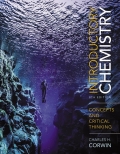
(a)
Interpretation:
The ionic charge with the help of periodic table for
Concept introduction:
The ionic charge is the electrical charge on an ion which occurs due to the gain or loss of one or more electron from an atom or group of atoms. When an atom gains an electron the negative charge develops on an atom and when it loses an electron the species become positively charged.
(b)
Interpretation:
The ionic charge with the help of periodic table for
Concept introduction:
The ionic charge is the electrical charge on an ion which occurs due to the gain or loss of one or more electron from an atom or group of atoms. When an atom gains an electron the negative charge develops on an atom and when it loses an electron the species become positively charged.
(c)
Interpretation:
The ionic charge with the help of periodic table for
Concept introduction:
The ionic charge is the electrical charge on an ion which occurs due to the gain or loss of one or more electron from an atom or group of atoms. When an atom gains an electron the negative charge develops on an atom and when it loses an electron the species become positively charged.
(d)
Interpretation:
The ionic charge with the help of periodic table for
Concept introduction:
The ionic charge is the electrical charge on an ion which occurs due to the gain or loss of one or more electron from an atom or group of atoms. When an atom gains an electron the negative charge develops on an atom and when it loses an electron the species become positively charged.
Want to see the full answer?
Check out a sample textbook solution
Chapter 12 Solutions
EBK INTRODUCTORY CHEMISTRY
- help 20arrow_forwardProvide the drawing of the unknown structure that corresponds with this data.arrow_forward20.44 The Diels-Alder reaction is not limited to making six-membered rings with only car- bon atoms. Predict the products of the following reactions that produce rings with atoms other than carbon in them. OCCH OCCH H (b) CH C(CH₂)s COOCH མ་ནས་བ (c) N=C H -0.X- (e) H C=N COOCHS + CH2=CHCH₂ →→arrow_forward
- 3) Draw a detailed mechanism and predict the product of the reaction shown? 1) EtMgBr 2) H3O+arrow_forwardHow to draw the mechanism for this reaction?arrow_forward> H₂C=C-CH2-CH3 B. H₂O Pt C. + H2 + H₂O H D. 16. Give the IUPAC name for each of the following: B. Cl Cl c. Cl Cl 17. Draw the line-angle formula for each of the following compounds: 1. phenol 2. 1,3-dichlorobenzene 3. 4-ethyltoluene < Previous Submit Assignment Next ▸arrow_forward
 Living By Chemistry: First Edition TextbookChemistryISBN:9781559539418Author:Angelica StacyPublisher:MAC HIGHERChemistry: Matter and ChangeChemistryISBN:9780078746376Author:Dinah Zike, Laurel Dingrando, Nicholas Hainen, Cheryl WistromPublisher:Glencoe/McGraw-Hill School Pub Co
Living By Chemistry: First Edition TextbookChemistryISBN:9781559539418Author:Angelica StacyPublisher:MAC HIGHERChemistry: Matter and ChangeChemistryISBN:9780078746376Author:Dinah Zike, Laurel Dingrando, Nicholas Hainen, Cheryl WistromPublisher:Glencoe/McGraw-Hill School Pub Co World of Chemistry, 3rd editionChemistryISBN:9781133109655Author:Steven S. Zumdahl, Susan L. Zumdahl, Donald J. DeCostePublisher:Brooks / Cole / Cengage Learning
World of Chemistry, 3rd editionChemistryISBN:9781133109655Author:Steven S. Zumdahl, Susan L. Zumdahl, Donald J. DeCostePublisher:Brooks / Cole / Cengage Learning Chemistry for Today: General, Organic, and Bioche...ChemistryISBN:9781305960060Author:Spencer L. Seager, Michael R. Slabaugh, Maren S. HansenPublisher:Cengage Learning
Chemistry for Today: General, Organic, and Bioche...ChemistryISBN:9781305960060Author:Spencer L. Seager, Michael R. Slabaugh, Maren S. HansenPublisher:Cengage Learning



